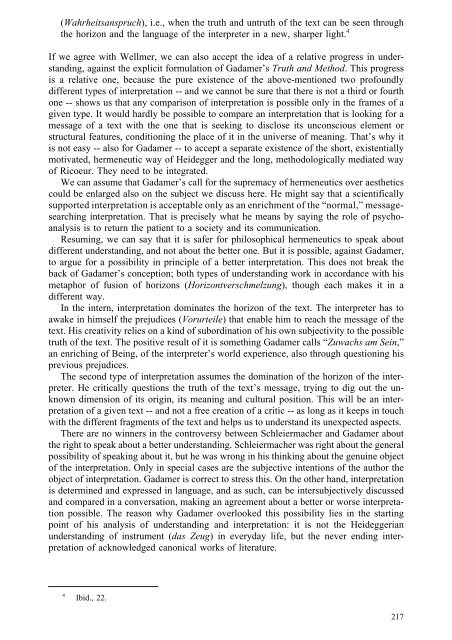[Andrzej_Wiercinski_(ed ... - WordPress.com
[Andrzej_Wiercinski_(ed ... - WordPress.com
[Andrzej_Wiercinski_(ed ... - WordPress.com
Create successful ePaper yourself
Turn your PDF publications into a flip-book with our unique Google optimized e-Paper software.
(Wahrheitsanspruch), i.e., when the truth and untruth of the text can be seen throughthe horizon and the language of the interpreter in a new, sharper light. 4If we agree with Wellmer, we can also accept the idea of a relative progress in understanding,against the explicit formulation of Gadamer’s Truth and Method. This progressis a relative one, because the pure existence of the above-mention<strong>ed</strong> two profoundlydifferent types of interpretation -- and we cannot be sure that there is not a third or fourthone -- shows us that any <strong>com</strong>parison of interpretation is possible only in the frames of agiven type. It would hardly be possible to <strong>com</strong>pare an interpretation that is looking for amessage of a text with the one that is seeking to disclose its unconscious element orstructural features, conditioning the place of it in the universe of meaning. That’s why itis not easy -- also for Gadamer -- to accept a separate existence of the short, existentiallymotivat<strong>ed</strong>, hermeneutic way of Heidegger and the long, methodologically m<strong>ed</strong>iat<strong>ed</strong> wayof Ricoeur. They ne<strong>ed</strong> to be integrat<strong>ed</strong>.We can assume that Gadamer’s call for the supremacy of hermeneutics over aestheticscould be enlarg<strong>ed</strong> also on the subject we discuss here. He might say that a scientificallysupport<strong>ed</strong> interpretation is acceptable only as an enrichment of the “normal,” messagesearchinginterpretation. That is precisely what he means by saying the role of psychoanalysisis to return the patient to a society and its <strong>com</strong>munication.Resuming, we can say that it is safer for philosophical hermeneutics to speak aboutdifferent understanding, and not about the better one. But it is possible, against Gadamer,to argue for a possibility in principle of a better interpretation. This does not break theback of Gadamer’s conception; both types of understanding work in accordance with hismetaphor of fusion of horizons (Horizontverschmelzung), though each makes it in adifferent way.In the intern, interpretation dominates the horizon of the text. The interpreter has toawake in himself the prejudices (Vorurteile) that enable him to reach the message of thetext. His creativity relies on a kind of subordination of his own subjectivity to the possibletruth of the text. The positive result of it is something Gadamer calls “Zuwachs am Sein,”an enriching of Being, of the interpreter’s world experience, also through questioning hisprevious prejudices.The second type of interpretation assumes the domination of the horizon of the interpreter.He critically questions the truth of the text’s message, trying to dig out the unknowndimension of its origin, its meaning and cultural position. This will be an interpretationof a given text -- and not a free creation of a critic -- as long as it keeps in touchwith the different fragments of the text and helps us to understand its unexpect<strong>ed</strong> aspects.There are no winners in the controversy between Schleiermacher and Gadamer aboutthe right to speak about a better understanding. Schleiermacher was right about the generalpossibility of speaking about it, but he was wrong in his thinking about the genuine objectof the interpretation. Only in special cases are the subjective intentions of the author theobject of interpretation. Gadamer is correct to stress this. On the other hand, interpretationis determin<strong>ed</strong> and express<strong>ed</strong> in language, and as such, can be intersubjectively discuss<strong>ed</strong>and <strong>com</strong>par<strong>ed</strong> in a conversation, making an agreement about a better or worse interpretationpossible. The reason why Gadamer overlook<strong>ed</strong> this possibility lies in the startingpoint of his analysis of understanding and interpretation: it is not the Heideggerianunderstanding of instrument (das Zeug) in everyday life, but the never ending interpretationof acknowl<strong>ed</strong>g<strong>ed</strong> canonical works of literature.4Ibid., 22.217


